Registered Vendors
Introduction/Purpose:
The Registered Vendors Master in a procurement system functions as a centralized database or repository that contains comprehensive and current information regarding the vendors or suppliers with whom an organization conducts business. The master database can be populated through various methods:
One approach involves integrating the procurement system with the organization’s finance system. This integration enables the automatic retrieval of vendor data from the finance system. By establishing this connection, the vendor information remains synchronized and up-to-date between the two systems. This integration facilitates efficient data management and reduces manual entry requirements.
Additionally, users within the organization have the ability to manually add vendors to the Vendor/Supplier Master. This feature proves valuable when incorporating new vendors into the system or when engaging with suppliers who are not part of the finance system. Users can directly input the necessary vendor details, such as name, address, contact information, and business particulars, into the procurement system, even offer the option to convert proposed vendors, identified during the procurement process, into active vendors within the system.
By utilizing these methods, organizations ensure that the Vendor/Supplier Master contains comprehensive and up-to-date information, encompassing all pertinent details essential for effective procurement operations.
Dependency:
The Vendor/Supplier Master has critical dependencies within a procurement system. Here are three key dependencies:
- Vendor/Supplier Basic Information: The Vendor/Supplier Master relies on accurate and complete basic information about vendors or suppliers. This includes details such as their names, addresses, contact information, and identification numbers. This information serves as the foundation for vendor identification, communication, and overall vendor management within the procurement system.
- Vendor/Supplier Trade Document/Contracts: The Vendor/Supplier Master is dependent on trade documents and contracts associated with each vendor or supplier. These documents include any other relevant contractual agreements. Storing and managing these documents within the master database ensures transparency, traceability, and compliance throughout the procurement process.
- Connection with Finance System (if integrated): Integration with the organization’s finance system is a critical dependency for the Vendor/Supplier Master. This connection allows for automatic fetching and synchronization of vendor data between the two systems. This integration streamlines financial transactions and facilitates accurate financial reporting within the procurement system.
By maintaining reliable and up-to-date vendor basic information, trade documents, and seamless integration with the finance system (if applicable), the Vendor/Supplier Master can effectively support procurement processes, vendor management, and financial operations within the procurement system.
How To Navigate:
The navigation to record a Vendor/Supplier in a procurement system typically involves the following steps:
- Click on the main navigation icon: The main navigation icon may be located in the top right corner of the screen. Clicking on this icon will open the navigation menu, which typically includes links to various sections of the procurement system.
- Click on the Other Master section: The Other Master section is located under the left section of the screen clicking on this section will display a list of Masters related to procuring.
- Find the Vendor section: The Vendor section is located in the list of Masters under the Master section. Clicking on this section will display a list of Master related to Vendor.
- Click on the Vendor/Supplier link: The Vendor/Supplier link is located under the Vendor section, after clicking on this link you can navigate Vendor/Supplier in the listing, and from that you can easily upload new transactions into the system.
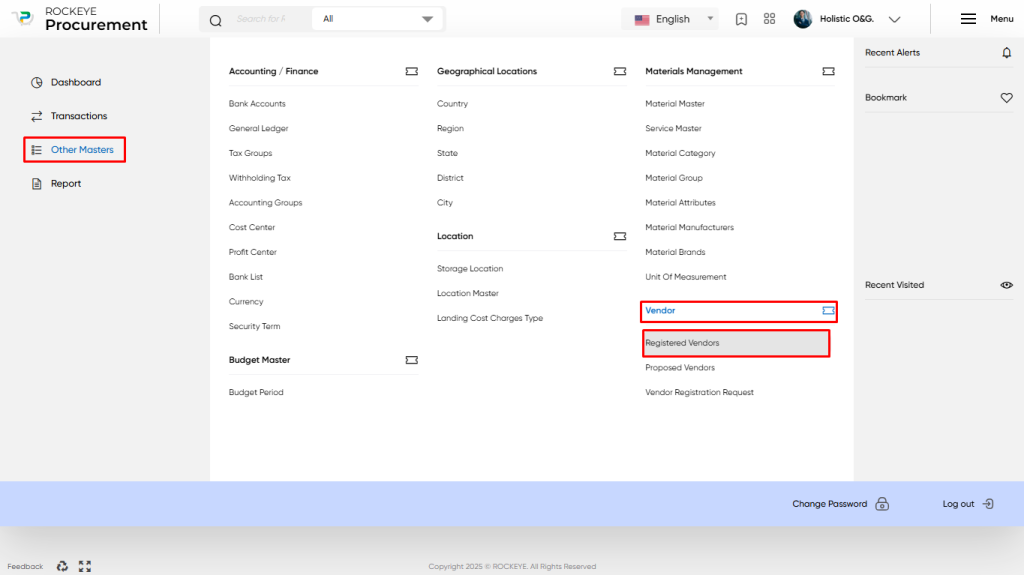
Listing:
The Vendor/Supplier Master Listing in a procurement system offers a comprehensive range of features and information for effective vendor management. Here’s an overview:
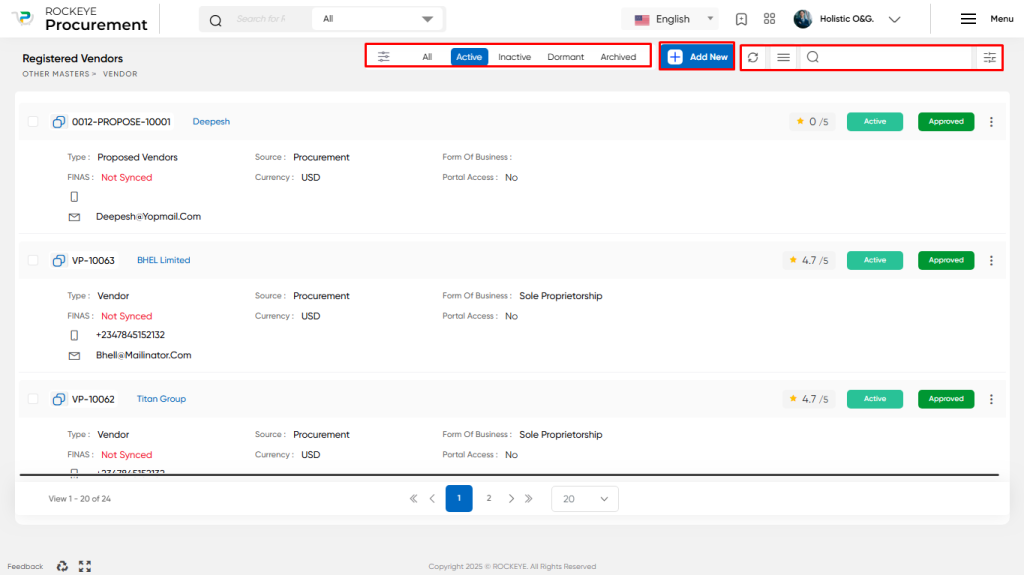
- Basic Search, Export, Refresh, Filter: The listing provides a user-friendly search function to quickly find vendors based on their names, codes, or other relevant criteria. Users can export the listing data for further analysis or reporting purposes. The refresh option ensures that the listing is up-to-date, and the filter function allows users to refine their search based on specific attributes.
- Integration Options: The system offers integration capabilities, such as syncing with Finas. This allows for automatic retrieval of vendor data, ensuring consistency and accuracy. Additionally, the system may provide options to pull vendor information from other companies, facilitating easy vendor onboarding.
- Additional Vendor Actions: The Vendor/Supplier Master listing includes various actions for vendors. Users can enable portal login access for vendors, allowing them to access self-service functionalities. The system also provides the ability to convert a vendor to a prospective vendor, indicating a potential future business relationship. Furthermore, users can blacklist a vendor to restrict further engagement.
- Card View: The listing presents the vendor’s Record in a card view format, where each vendor is displayed as a card containing important details. This includes the vendor’s name, code, financial balance in Finas, portal access status, currency used, vendor rating, active status, approval status, contact number, email address, Activity Log, Rating History, and more. The card view provides a concise and visual representation of key vendor information, facilitating quick and easy reference.
By offering basic search, export, refresh, and filter functionalities, along with integration options, portal access management, conversion of vendors, blacklisting capabilities, and a card view representation of essential details, the Vendor/Supplier Master Listing empowers users to efficiently manage and analyze vendor information within the procurement system.
Recording & Update:
The Vendor/Supplier Master Record/Update functionality in a procurement system is essential for managing and updating vendor information. Here is a detailed description of each component:
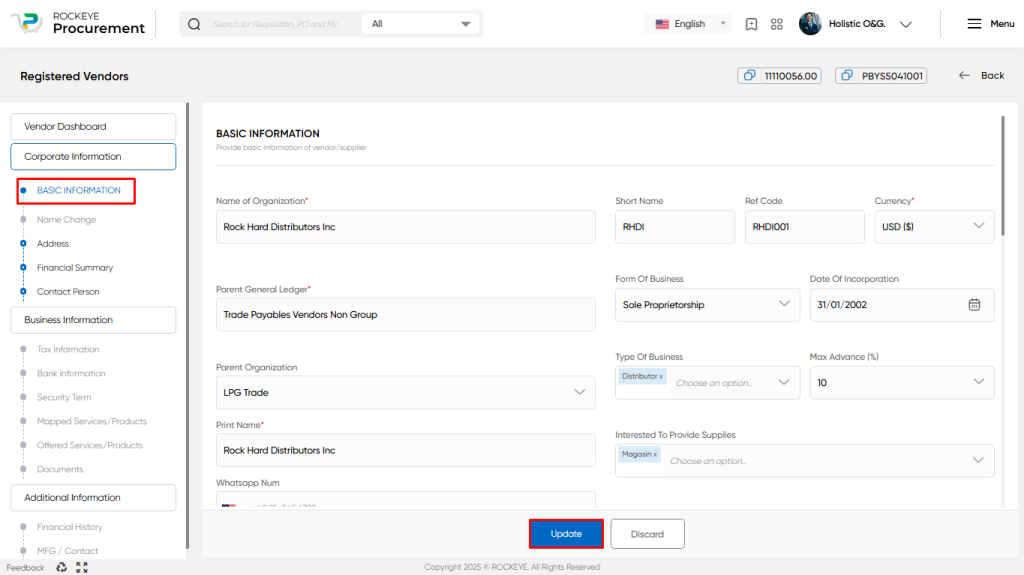
- Dashboard: Vendors are provided with a personalized dashboard that offers valuable insights based on their transaction history. It includes metrics such as the count of purchase orders, goods received, purchase invoices, service completions, and open purchase orders. Additionally, the dashboard highlights the top 5 products based on purchase, provides monthly statistics, and incorporates rating parameters. This comprehensive overview allows vendors to track their performance, identify trends, and make data-driven decisions.
The Corporate Information section in the Vendor/Supplier Corporate Information tab of the Procurement System captures Basic details related to the vendor’s business. Here is a breakdown of the information included:
- Name of the organization: This field captures the name of the vendor’s organization or firm.
- Parent GL (General Ledger) account: It refers to the parent account in the General Ledger system associated with the vendor’s organization.
- Type of business: This field specifies the type of business the vendor is engaged in, such as manufacturing, retail, or services.
- Form of business: It indicates the legal structure of the vendor’s organization, such as sole proprietorship, partnership, corporation, or any other applicable form.
- Maximum Advance: This field records the maximum advance amount allowed for the vendor, which refers to the prepayment or advance payment limit set by the organization.
- Associated business group: If the vendor is part of a larger business group or conglomerate, this field captures the association with the respective group.
- Payment terms: It specifies the agreed-upon terms for payment between the organization and the vendor, including factors like payment due dates, discounts, or penalties.
- Preferred bank: This field allows the vendor to specify their preferred bank for financial transactions with the organization.
- Contact details: This section includes various contact information for the vendor, such as the WhatsApp number, email address, mobile number, and fax number. These details facilitate communication and collaboration.
- Corporate address details: This field captures the complete address of the vendor’s corporate office, including street address, city, state, postal code, and country. It provides a physical location for correspondence and communication purposes.
- Name Change History: The system maintains a record of any name changes that the vendor has undergone. This historical data helps in tracking and referencing past names associated with the vendor, ensuring accuracy and consistency in vendor identification.
The Corporate Information tab in the procurement system ensures that the organization has a holistic understanding of the vendor’s corporate structure, facilitates effective communication, and enables collaboration throughout the procurement process.
The Business Information section in the Vendor/Supplier Corporate Information tab of the Procurement System captures important details related to the vendor’s business. Here is a breakdown of the information included:
- Tax Information: This field allows vendors to provide their tax-related details, such as the tax number and tax type. It ensures compliance with relevant taxation regulations and helps the organization accurately manage tax-related processes.
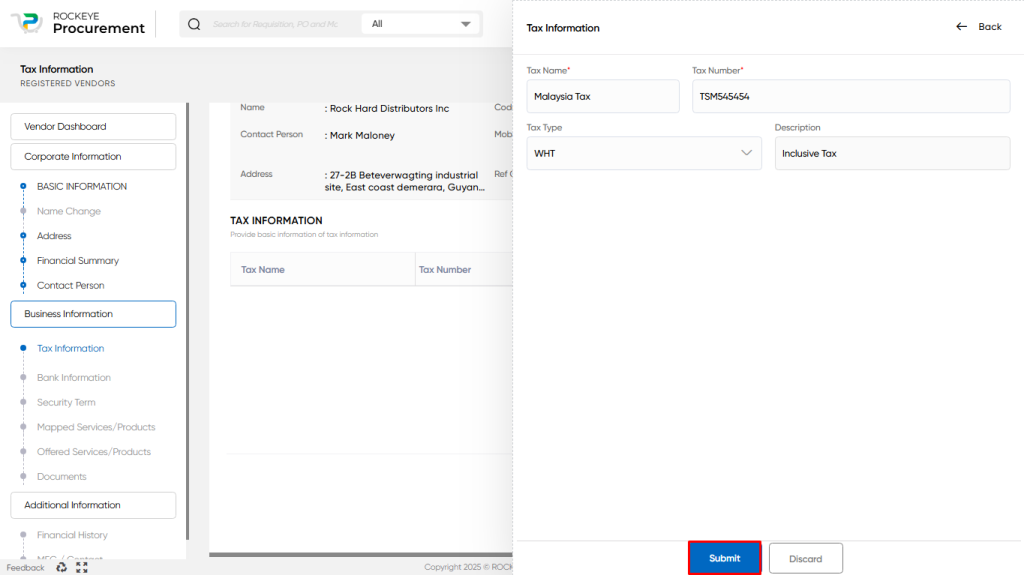
- Bank Information: Vendors can store their bank details in this section. It enables them to specify their default bank for financial transactions with the organization. This information streamlines the payment process and facilitates smooth financial transactions.
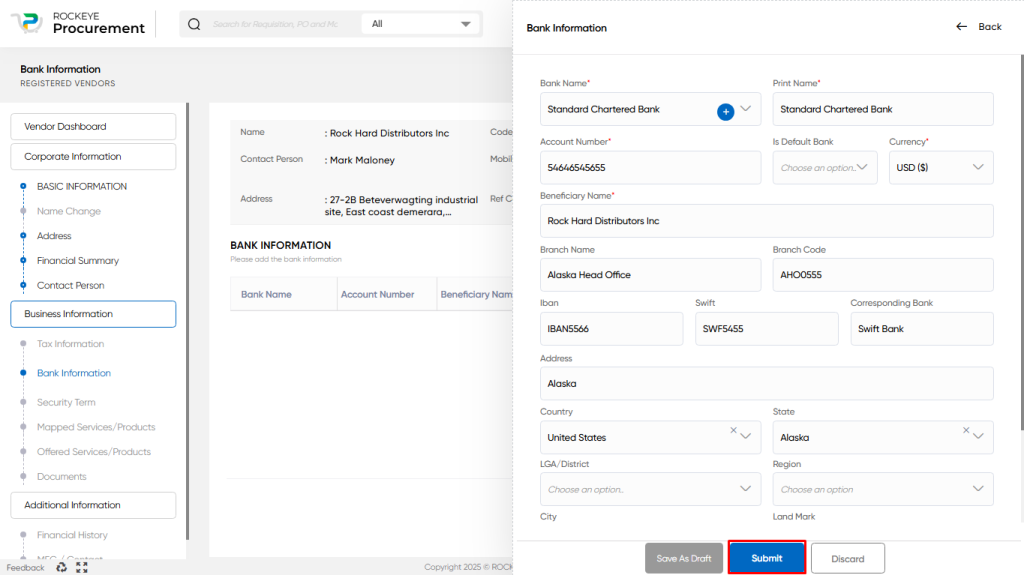
- Security: In this field, vendors can define the type of security document requirements for their engagement with the organization. It allows vendors to communicate specific security measures necessary to protect their business interests or sensitive information.
- Mapped Service/Product: The system provides functionality for vendors to specify the services or products they offer and map them to specific categories or codes. This helps streamline the procurement process by accurately categorizing vendor offerings and simplifying item identification during purchasing activities.
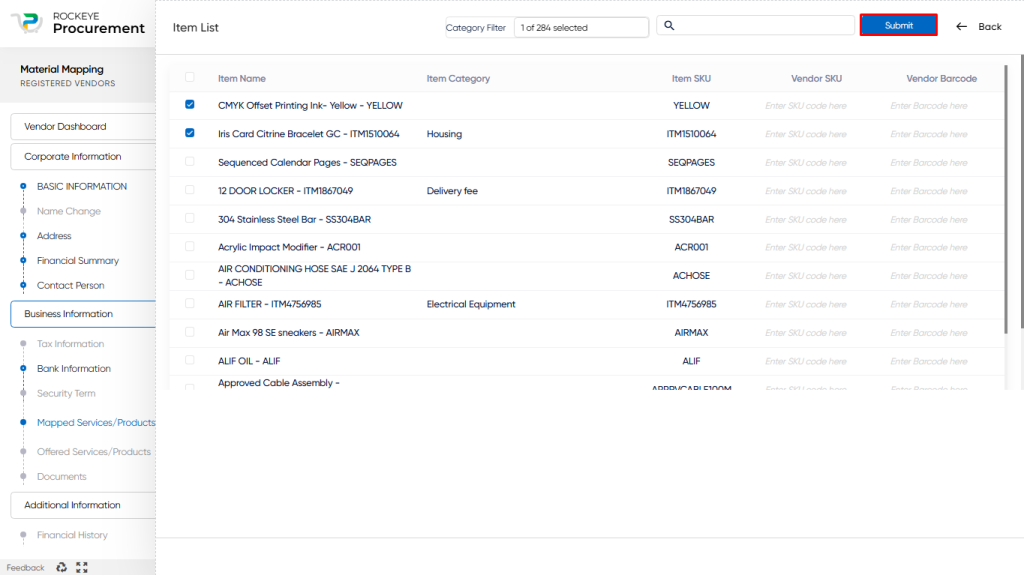
- Offered Service/Product: This section provides a comprehensive list of the specific items or services offered by the vendor. It allows vendors to showcase their range of offerings, making it easier for the organization to identify suitable vendors for specific procurement requirements.
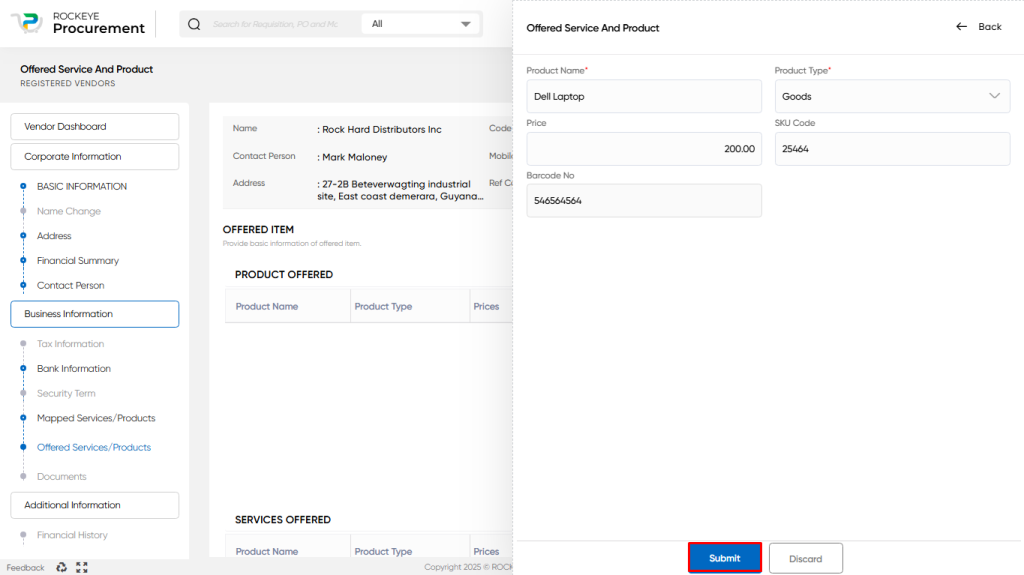
- Documents: Vendors can upload and store various business-related documents in this section. This may include certifications, licenses, contracts, or any other relevant documents. Storing these documents within the procurement system ensures easy access, efficient document management, and compliance with record-keeping requirements.

By capturing these business-related details, the Vendor/Supplier Corporate Information tab in the Procurement System enables organizations to have a comprehensive understanding of their vendors. It streamlines communication, ensures compliance with tax regulations, simplifies item identification, and facilitates efficient document management, contributing to effective vendor management and smooth procurement processes.
- Additional Information: This section provides space to store additional details about the vendor. Financial history captures relevant financial data, allowing the organization to assess the vendor’s financial stability and performance. The MFG/Contact section allows vendors to provide manufacturing details or additional contact information. The customer reference feature allows for the inclusion of testimonials or references from other customers who have previously engaged with the vendor, providing insights into their reputation and quality of service.
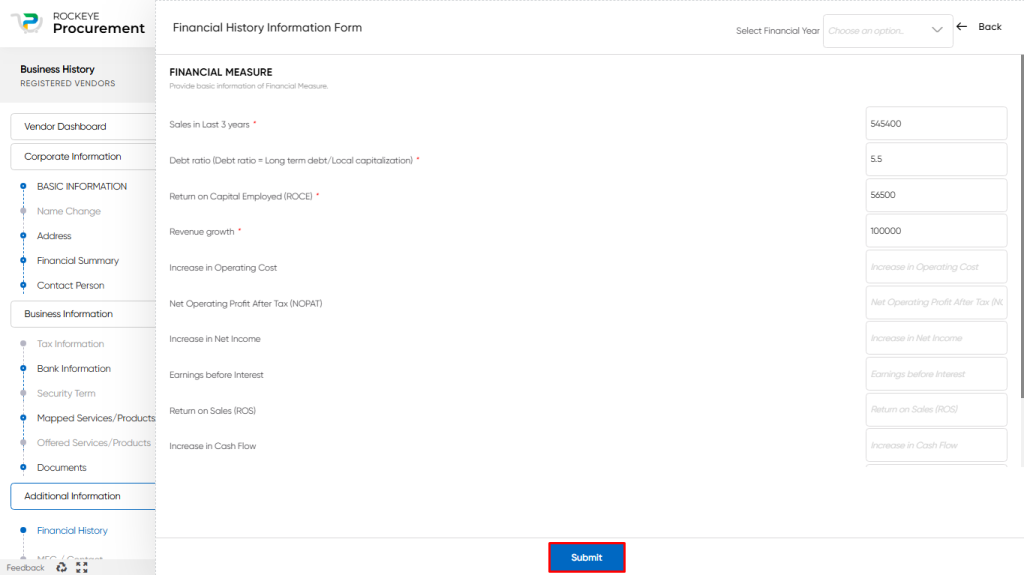
- Business History: This section allows for the recording of vendor-specific business details and upcoming delivery information. It captures important aspects such as the vendor’s business activities, historical performance, and future delivery schedules. This information helps track the vendor’s progress, assess their reliability and capability, and make informed decisions when engaging with them for future projects.
By maintaining and updating the Vendor/Supplier Master Record in the procurement system, organizations can effectively manage vendor relationships, evaluate vendor performance, ensure compliance, and make informed decisions throughout the procurement process. It provides a comprehensive repository of vendor information that enhances transparency, efficiency, and collaboration within the procurement ecosystem.
The user can perform the following actions in this section:
- Submit: This option allows the user to publish the transaction information. If the system has an approval flow, the maker will submit the information, and it will be sent to the approval authority or checker for approval.
- Discard: This option allows the user to discard the transaction before saving it.
Key Notes Vendor/Supplier:
- The procurement system offers the ability to search and pull vendor information from FINAS when adding new vendors.
- The system allows for granting vendor portal access directly from the vendor listing view, providing an extra level of convenience and efficiency.
- When the Procurement System is integrated with FINAS, it will retrieve and display the current balance for each vendor from the FINAS system.